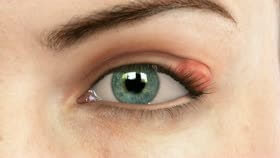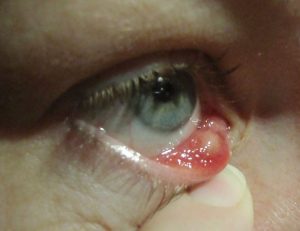
Although they are an annoyance to most who periodically get a chalazion, they are not inherently dangerous or cause serious vision issues. If left untreated however, they can become more than a mere aggravation and eventually chalazia (plural) can result in more serious visual issues.
We will review the causes and treatments of chalazion and what you should know about them.
Signs You May have a Chalazion
A chalazion is a small bump on your eyelid, either upper or lower. It is not a stye, which is a bacterial infection, but it can be confused with one.
Chalazion comes from the Greek word meaning, “small lump.” In general, it is caused by a blockage in the Meibomian gland in your eyelids. This gland produces oil to help lubricate your eyes, and when it becomes blocked or inflamed, the oil will back up in the gland leaving a mostly painless bump on your lid.
Occasionally it can become red, swollen and tender. You can have one in both eyes at the same time and you can have more than one a single eye. Chalazia can also occur in the lower and upper eyelid.
Treatment for a Chalazion
The best initial treatment for chalazia is simple warm compresses. Using a soft cloth and warm water gently apply it to the affected area. Usually it is recommended to do this 4-6 times a day for 10-15 minutes.
Apply the warm compresses for several days until the gland drains and the condition is resolved. In most cases that is all the treatment needed. Do NOT attempt to pinch it, squeeze it or try to “pop” it.
When it drains, keep the area clean and avoid touching it with your hands.
If it persists, then you should schedule an appointment with your eye care professional.
When Additional Treatment is Needed
If this at-home treatment is not successful, then seek out further medical treatment. Your doctor may prescribe an antibiotic ointment. Sometimes a chalazion can be so large that it begins to press into your cornea affecting your vision.
Your ophthalmologist will determine if the best course of treatment is a surgical procedure to drain the chalazion. This is usually done in the office under a local anesthetic.
Risk Factors and Causes of a Chalazion
There are certain conditions that can promote the growth of a chalazion and become risk factors for their chronic development.
- Blepharitis is an inflammation of the eyelids. This chronic condition leads to inflamed and swollen eyelids with oil and bacteria near the margins of the eyelids.
- This in turn is associated with acne rosacea
- Tuberculosis
- Viral infections
- Seborrhea
 An important way to minimize the development of chalazia is to consistently practice good eyelid hygiene. That includes cleaning your eyelids and lashes each night before bed. Most people will wash their face, but many forget to cleanse their eyelids. There are specific lid cleaners available to safely remove the oils and bacteria deposited there on a daily basis.
An important way to minimize the development of chalazia is to consistently practice good eyelid hygiene. That includes cleaning your eyelids and lashes each night before bed. Most people will wash their face, but many forget to cleanse their eyelids. There are specific lid cleaners available to safely remove the oils and bacteria deposited there on a daily basis.
Women should diligently remove all eye makeup each night before bedtime. If you don’t remove all traces of eyeliner, mascara and shadows, you allow bacteria to collect on your lids. This can develop into blocked glands resulting in a chalazion.
Although extremely rare, if a patient develops recurring chalazia in the same area, your ophthalmologist may want to have a biopsy performed to rule out a tumor or cancer.
If you have a nodule or bump or your eyelid that will not go away,
or if you have questions about a Chalazion treatment,
contact the specialists at South Texas Eye Institute.

